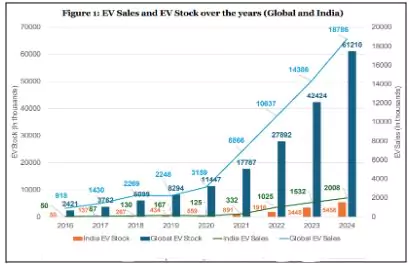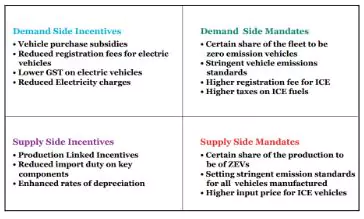Recently, NITI Aayog launched the report “Unlocking a $200 Billion Opportunity: Electric Vehicles (EV) in India” to accelerate the nation’s electric mobility transition.
The Ministry of Heavy Industries has unveiled detailed guidelines for the “Scheme to Promote Manufacturing of Electric Passenger Cars in India” (SPMEPCI).
Key Highlights of the Report

- Target for EV: India aims for 30% EV sales by 2030, up from 2.08 million units sold in 2024.
- This can unlock a $200 billion economy through fuel savings and reduced import dependence, Job generation and Cutting Emission.
- Global Comparison: India’s EV adoption is increasing but lags behind leading markets like the U.S., EU, and China in scale and speed.
- Segment-Wise Progress: Strong growth in electric two-wheelers and three-wheelers, moderate progress in electric buses, slow uptake of electric cars, and negligible presence of long-haul electric trucks.
- Current Penetration: EVs formed 7.6% of total vehicle sales in 2024, reflecting gradual growth but still far from the desired pace
- India has taken nearly 10 years to reach this penetration.
- Barriers: Slow initial adoption and infrastructure gaps, and proposes strategic unlocks to boost penetration.
- Future Requirement: To meet the 30% EV sales target by 2030, India must increase adoption by over 22% within the next five years.
Challenges in adaptation of EV
- Financing Constraints for Heavy EVs: High costs (two or three times of ICE vehicles) and fragmented ownership (80% truck owners and most bus operators are small) deter financing for electric buses and trucks due to EMI and data uncertainties.
- Charging Infrastructure Gaps: Public charging suffers from poor utilisation, land and power supply hurdles, and high costs (18% GST), compounded by weak coordination among DISCOMs, ULBs, and transport agencies.
- Awareness and Perception Barriers: Misconceptions (fire safety, range anxiety) and fragmented awareness campaigns obscure Total Cost of Ownership benefits, discouraging EV adoption among cost-conscious Indian buyers.
- Data and Regulatory Deficiencies: VAHAN’s inaccurate EV categorisation and absence of battery IDs hinder policy design, recycling, and lifecycle tracking, weakening evidence-based planning.
- Indian Market Complexity: With 75% two-wheelers, 98% small/public vehicles, and 15% trips exceeding 10 km, EV strategies must reflect India’s distinct mobility patterns and affordability challenges.
Recommendation to overcome the Challenges
- Shift from Incentives to Mandates: Announce Zero Emission Vehicle (ZEV) timelines, expand Corporate Average Fuel Efficiency (CAFÉ) norms, and phase out Internal Combustion Engine (ICE) vehicles through progressively stringent regulations.
CAFÉ Norms
- Regulations that require car manufacturers to ensure their entire fleet of new vehicles sold in a given financial year meets a specific average fuel efficiency and, by extension, a maximum average Carbon Dioxide (CO2) emission target.
- The Bureau of Energy Efficiency (BEE), under the Ministry of Power, is the nodal agency for implementing and monitoring CAFÉ norms.
- CAFÉ I (2017–22): Fleet-wide CO₂ target – 130 g/km.
- CAFÉ II (2022– onwards): Stricter target – 113 g/km (13% cut).
- CAFÉ III & IV (Proposed): The government has proposed even stricter future phases, with a target of approximately 91.7 g/km for CAFÉ III, to be implemented from 2027.
CAFÉ Norms vs. Bharat Stage (BS) Norms
- Focus: CAFÉ norms regulate CO₂ emissions (climate change), whereas BS norms regulate NOx, CO, PM and other pollutants (local air quality).
- Scope: CAFÉ norms apply to a fleet-wide average for a manufacturer’s total sales, whereas BS norms apply to each individual vehicle model.
- Objective: CAFÉ norms aim to reduce greenhouse gases and improve fuel economy, whereas BS norms aim to reduce harmful pollutants and improve local air quality.
|

- Saturation-Based EV Deployment: For example, launch a program to saturate 5 cities with 100% e-Buses, e-Paratransit, and e-Freight vehicles, scaling up to 20 and eventually 100 cities for deeper adoption.
- China’s “10 Cities, 1000 Vehicles” program launched in 2009 targeted 1,000 new energy vehicles per city, focusing on buses, taxis, and government fleets with subsidies and local policies.
- It was expanded to 25+ cities which boosted domestic manufacturing, advanced battery technology, built charging infrastructure, and laid the foundation for China’s global EV leadership.
- Affordable Financing for Heavy EVs: Create a blended fund with public and multilateral contributions to provide low-interest loans for e-Buses and e-Trucks, reducing capital costs for small operators.
- Strategic Infrastructure and Technology Push: Develop battery leasing, unified EV apps, and special EV power lines while identifying 20 high-density corridors for charging hubs and advancing new battery chemistries.
- Awareness and Data Systems: Establish nationwide awareness programs and comprehensive EV databases to address performance misconceptions and support evidence-based policymaking.
PWOnlyIAS Extra Edge
India’s Automotive Sector
- Global Rank: India is the fourth-largest automobile market globally in terms of production and the third-largest in terms of sales.
- Economic Contribution: The automotive sector contributes approximately 7.1% to India’s GDP and is a key driver of employment and manufacturing.
- Key Growth Drivers (Government Initiatives):
- Production Linked Incentive (PLI) Scheme for Automobile and Auto Components (PLI-Auto): Aims to boost domestic manufacturing of Advanced Automotive Technology (AAT) products.
- Production Linked Incentive (PLI) Scheme for Advanced Chemistry Cells (PLI-ACC): Promotes domestic battery manufacturing for EVs.
- FAME (Faster Adoption and Manufacturing of Hybrid and Electric Vehicles) Scheme: Provides incentives for EV buyers and charging infrastructure development.
- Electric Mobility Promotion Scheme (EMPS) 2024: A new scheme designed to continue incentivizing EV adoption, particularly for electric two-wheelers and three-wheelers, after the FAME II scheme ended.
Government Initiatives to Promote EVs
- National Electric Mobility Mission Plan (2013): Serves as an umbrella policy framework to promote EVs and hybrid technologies.
- Faster Adoption and Manufacturing of Hybrid and Electric Vehicles (FAME I – 2015, FAME II – 2019): Provides demand incentives and charging infrastructure support to accelerate EV uptake.
- State EV Policies (2017 onwards): States offer subsidies, tax exemptions, and charging infrastructure support to localize EV growth.
- For example Maharashtra EV policy 2025 provides a 10% subsidy on the base price of electric two-wheelers, three-wheelers, private four-wheelers, and certain electric buses.
- PLI-ACC, 2021: Promotes domestic battery manufacturing to reduce import dependence.
- Battery Waste Management Rules (2022): Mandates Extended Producer Responsibility for safe collection and recycling of EV batteries.
|
Conclusion
India’s EV transition demands mandates, financing support, infrastructure push, and awareness, drawing lessons from global models like China and addressing the complexity with the Indian market to meet 30% EV sales by 2030 and achieve sustainable, affordable, and technology-driven mobility.
Read More About: SPMEPCI
![]() 5 Aug 2025
5 Aug 2025



